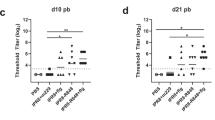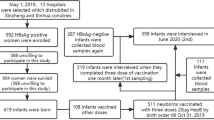Abstract
Vertically transmitted hepatitis B virus (HBV) usually causes chronic infection. While combined active–passive immunoprophylaxis in neonates of hepatitis B surface antigen-positive (HBsAg+) mothers at birth prevents vertical transmission, it is not yet clear whether neonates encounter the virus or its products in the absence of hepatitis B e antigen (HBeAg). This study was undertaken to investigate HBV antigen-specific T-cell responses in vaccinated neonates of HBsAg+/HBeAg− mothers. Blood was collected from 46 HBsAg+ mothers and their neonates (subjects) as well as 24 age-matched controls. All neonates of HBsAg+ mothers received appropriate immunoprophylaxis, and HBsAg and hepatitis B surface antibody (anti-HBs) antibody titers were determined after completion of the vaccination course. Peripheral blood mononuclear cells (PBMCs) from infants at birth, 1 and 6 months of age were stimulated with recombinant HBsAg, hepatitis B core antigen (HBcAg) and mitogen, and interferon (IFN)-γ concentrations were determined by ELISA. HBsAg-induced production of IL-2, IL-5, IL-6 and IL-10 was assessed using a cytometric bead array kit on cells from 6-month-old neonates post-vaccination. All neonates were HBsAg− and responded to vaccination. Increased IFN-γ production following HBcAg stimulation was seen in 30.4% of neonates born to HBsAg+/HBeAg− mothers. Subjects demonstrated significantly higher IL-2 production post-HBsAg stimulation, whereas IL-5, IL-6 and IL-10 cytokine responses were not significantly different. Almost one-third of uninfected neonates developed viral antigen-induced IFN-γ production, suggesting that they had been exposed to virions or viral derivatives. This encounter, however, did not impair their T-cell responses to vaccination.
This is a preview of subscription content, access via your institution
Access options
Subscribe to this journal
Receive 12 digital issues and online access to articles
$119.00 per year
only $9.92 per issue
Buy this article
- Purchase on Springer Link
- Instant access to full article PDF
Prices may be subject to local taxes which are calculated during checkout



Similar content being viewed by others
References
Hyams KC . Risks of chronicity following acute hepatitis B virus infection: a review. Clin Infect Dis 1995; 20: 992–1000.
McMahon BJ, Alward WL, Hall DB, Heyward WL, Bender TR, Francis DP et al. Acute hepatitis B virus infection: relation of age to the clinical expression of disease and subsequent development of the carrier state. J Infect Dis 1985; 151: 599–603.
Akhter S, Talukder MQ, Bhuiyan N, Chowdhury TA, Islam MN, Begum S . Hepatitis B virus infection in pregnant mothers and its transmission to infants. Indian J Pediatr 1992; 59: 411–415.
Stevens CE, Beasley RP, Tsui J, Lee WC . Vertical transmission of hepatitis B antigen in Taiwan. N Engl J Med 1975; 292: 771–774.
Lin HH, Lee TY, Chen DS, Sung JL, Ohto H, Etoh T et al. Transplacental leakage of HBeAg-positive maternal blood as the most likely route in causing intrauterine infection with hepatitis B virus. J Pediatr 1987; 111 (6 Pt 1): 877–881.
Milich DR, Jones JE, Hughes JL, Price J, Raney AK, McLachlan A . Is a function of the secreted hepatitis B e antigen to induce immunologic tolerance in utero? Proc Natl Acad Sci USA 1990; 87: 6599–6603.
Yue Y, Meng J, Zhang S . Mechanism of peripheral blood mononuclear cell invasion by HBV on artificial immunization in newborns. Chin Med J (Engl) 2002; 115: 1380–1382.
Milich D, Liang TJ . Exploring the biological basis of hepatitis B e antigen in hepatitis B virus infection. Hepatology 2003; 38: 1075–1086.
Ranger-Rogez S, Alain S, Denis F . Hepatitis viruses: mother to child transmission. Pathol Biol (Paris) 2002; 50: 568–575. French.
Wang F, Zhang J, Yang H, Li X, Wen S, Guo Y et al. Quantitative analysis of HBV DNA level and HBeAg titer in hepatitis B surface antigen positive mothers and their babies: HBeAg passage through the placenta and the rate of decay in babies. J Med Virol 2003; 71: 360–366.
Kane M . Global programme for control of hepatitis B infection. Vaccine 1995; 13 (Suppl. 1): S47–S49.
Lazizi Y . Trasplacental passage of hepatitis B virus DNA from hepatitis B e antigen-negative mothers and delayed immune response in newborns. J Infec Dis 1994; 169: 704–706.
Paraskevis D, Haida C, Tassopoulos N, Raptopoulou M, Tsantoulas D, Papachristou H et al. Development and assessment of a novel real-time PCR assay for quantitation of HBV DNA. J Virol Methods 2002; 103: 201–212.
Paraskevis D, Katsoulidou C, Moschidis Z, Hatzitheodorou E, Varaklioti A, Hatzakis A . Development of a flexible and sensitive in-house real-time PCR assay for the quantification of HBV DNA. Proceeding of XVIIth Regional Congress. Madrid: International Society of Blood Transfusion, 2007.
Jafarzadeh A, Shokri F . The antibody response to HBs antigen is regulated by coordinated Th1 and Th2 cytokine production in healthy neonates. Clin Exp Immunol 2003; 131: 451–456.
Ota MO, Vekemans J, Schlegel-Haueter SE, Fielding K, Whittle H, Lambert PH et al. Hepatitis B immunisation induces higher antibody and memory Th2 responses in new-borns than in adults. Vaccine 2004; 22: 511–519.
Brunetto MR, Giarin MM, Oliveri F, Chiaberge E, Baldi M, Alfarano A et al. Wild-type and e antigen-minus hepatitis B viruses and course of chronic hepatitis. Proc Natl Acad Sci USA 1991; 88: 4186–4190.
Pontisso P, Vidalino L, Quarta S, Gatta A . Biological and clinical implications of HBV infection in peripheral blood mononuclear cells. Autoimmun Rev 2008; 8: 13–17.
Jafarzadeh A, Kardar G, Khoshnoodi J, Shokri F . Downregulation of IL-12 production in healthy non-responder neonates to recombinant hepatitis B vaccine. Iran Biomed J 2004; 8: 41–45.
Keating GM, Noble S . Recombinant hepatitis B vaccine (Engerix-B): a review of its immunogenicity and protective efficacy against hepatitis B. Drugs 2003; 63: 1021–1051.
Chang MH . Hepatitis B virus infection. Semin Fetal Neonatal Med 2007; 12: 160–167.
Borkowsky W, Krasinski K, Moore T, Papaevangelou V . Lymphocyte proliferative responses to HIV-1 envelope and core antigens by infected and uninfected adults and children. AIDS Res Hum Retroviruses 1990; 6: 673–678.
Rich KC, Siegel JN, Jennings C, Rydman RJ, Landay AL . Function and phenotype of immature CD4+ lymphocytes in healthy infants and early lymphocyte activation in uninfected infants of human immunodeficiency virus-infected mothers. Clin Diagn Lab Immunol 1997; 4: 358–361.
Pride MW, Thakur A, Thanavala Y . Mimicry of the a determinant of hepatitis B surface antigen by an antiidiotypic antibody. I. Evaluation in hepatitis B surface antigen responder and nonresponder strains. J Exp Med 1993; 177: 127–134.
Koumbi L, Papadopoulos N, Anastassiadou V, Machaira M, Kafetzis D, Papaevangelou V . Dendritic cells in uninfected infants born to hepatitis B virus positive mothers. Clin Vaccine Immunol 2010; in press.
Li RB, Chen HS, Xie Y, Fei R, Cong X, Jiang D et al. Dendritic cells from chronic hepatitis B patients can induce HBV antigen-specific T cell responses. World J Gastroenterol 2004; 10: 1578–1582.
Acknowledgements
The authors thank Glaxo SmithKline Biologicals, Belgium, and Rhein Biotech Dynavax, Germany, for kindly providing the purified preparations of HBsAg and HBc antigens, respectively. We are particularly grateful to the subjects and the mothers who allowed their babies to be enrolled in the study. We also thank Dr Apostolos Bossios and Dr Christina Piperi for their consultation assistance in developing the experimental techniques used in this study. The study was cofunded by the European Social Fund and National Resources—(EPEAEK II) PYTHAGORAS and was also supported by a European Society of Pediatric Diseases Small Grant and a fellowship from the European Society of Clinical Microbiology and Infectious Diseases.
Author information
Authors and Affiliations
Corresponding author
Additional information
Note: Supplementary information is available on the Cellular & Molecular Immunology website.
Supplementary information
Rights and permissions
About this article
Cite this article
Koumbi, L., Bertoletti, A., Anastasiadou, V. et al. Hepatitis B-specific T helper cell responses in uninfected infants born to HBsAg+/HBeAg− mothers. Cell Mol Immunol 7, 454–458 (2010). https://doi.org/10.1038/cmi.2010.34
Received:
Revised:
Accepted:
Published:
Issue Date:
DOI: https://doi.org/10.1038/cmi.2010.34
Keywords
This article is cited by
-
Asian Pacific association for the study of liver (APASL) guidelines: hepatitis B virus in pregnancy
Hepatology International (2022)
-
Presence of Precore (C)/C Promoter Mutants in Peripheral Blood Mononuclear Cells of Chronic Hepatitis B (CHB) Carriers During Pregnancy Does Not Correlate with Increased Risk of Liver Disease in 4 Years of Follow-Up
Digestive Diseases and Sciences (2020)
-
An Assessment of Upper Limits of Normal for ALT and the Impact on Evaluating Natural Course of Chronic Hepatitis B Virus Infection in Chinese Children
American Journal of Gastroenterology (2018)
-
In utero development of memory T cells
Seminars in Immunopathology (2017)
-
Tolerance and immunity to pathogens in early life: insights from HBV infection
Seminars in Immunopathology (2017)



